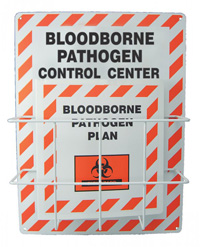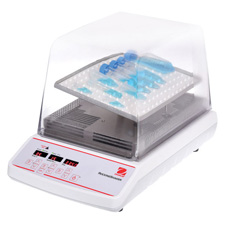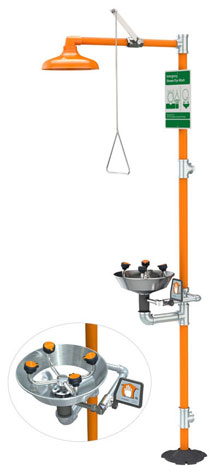Definition
A fume hood, technically a laboratory chemical hood, is a type of local exhaust ventilation system (engineering control). A typical fume hood is cabinet with a moveable front sash (window) made out of safety glass. Air is drawn into the hood under and through the opened sash and is exhausted through openings in the rear and top of the cabinet to a remote point such as an exhaust stack on the roof of the building.
A properly used and properly functioning fume hood exhausts hazardous gases, dusts, mists, and vapors from a confined location and helps protect workers from inhalation exposure.
A biological safety cabinet is similar to a fume hood in outward appearance but is designed for work with pathogens (infectious microorganisms) or materials contaminated with pathogens requiring a specific biosafety level.
Biosafety cabinets (BSC's) are designed to protect the user, the environment, and the material whereas fume hoods are designed to protect the user and others in that workspace. For example, a fume hood typically exhausts a toxic chemical to a roof stack where it is diluted to such a low concentration that it is unlikely to harm someone. In contrast, it would be a very bad idea to release a pathogen such as Ebola or coronavirus to the environment, even if diluted, so biosafety cabinets are equipped with HEPA filters to remove the biological material. Biological safety cabinets may not be safe for use with toxic chemicals unless they exhaust the filtered air outside the lab/work space. There has been at least one report of an explosion caused by the use of flammable chemicals in a BSC.
Additional Info
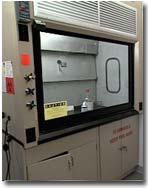
A typical bench-mounted
laboratory fume hood.
Key points about fume hoods are:
- Fume hoods are not meant to be storage devices (unless specifically designated as such). Storage of incompatible materials and/or hazardous wastes in fume hoods have caused numerous accidents, many of which have caused death or injury. Here is an example of a fume hood fire/explosion that resulted from such sloppiness.
- Fume hoods are not waste disposals. Do not let organic chemicals evaporate in the hood - use a proper waste bottle. Do not leave uncapped bottles of chemicals or waste in a hood.
- Never block the air flow. The slats/baffles in the rear of the hood are part of the air flow system. Obstructing these by storing chemicals, apparatus and garbage in the hood can interfere with the safe operation of the hood. NEVER let your hood look like the one shown below!
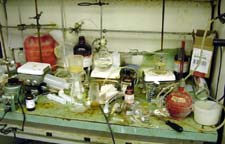
Note: There is no specific OSHA requirement for fume hood flow monitors, although paragraph (e)(3)(iii) of the Laboratory Standard, 29 CFR 1910.1450 does require that "fume hoods and other protective equipment are functioning properly". Some states do require airflow monitors. For example, Title 8 of California Code of Regulations 5154.1 requires "quantitative airflow monitor that continuously indicates whether air is flowing into the exhaust system during operation." This does not specify the type of device, which can range from a simple liquid manometer to an electronic feedback system.
Other non-governmental standards call for airflow monitors. These include:
- ANSI/ASHRAE Standard 110 - Method of Testing Performance of Laboratory Fume Hoods
- NSI/AIHA Standard Z9.5 - Laboratory Ventilation
- NFPA 45, 2004 - Standard on Fire Protection for Laboratories Using Chemicals which requires a "...measuring device for hood airflow shall be a permanently installed device and shall provide constant indication to the hood user of adequate or inadequate hood airflow."
Some safe hood usage tips:
- Check the air flow before and during use. If your fume hood is not equipped with an air flow indicator/alarm, try holding a small piece of paper near the bottom of the sash to see if air is flowing into the hood in its normal fashion. If you suspect the hood is not operating properly, do not use it until it has been repaired and certified for use. See Further Reading for links to information about air flow considerations.
- Do not use perchloric acid in a fume hood unless it is specially designed for this purpose. Explosive perchlorate salts could accumulate in the exhaust system.
- Never stick your head into the fume hood! Keep the sash between your face and your experiment whenever possible. Keep the sash lowered at all times except when you need to access your experiment/equipment.
- Position apparatus as far back in the hood as possible. Air flow is not as efficient at the front of the hood.
- Fume hoods are good at containing fires, explosions etc., but if the potential for an explosion exists, use an auxiliary blast shield as well.
- Avoid working opposite a fume hood if possible. Dangerous procedures are often carried out in hoods.
- Remove all unnecessary materials (especially containers of waste or solvents) when performing an experiment/procedure in a fume hood.
Books Available
- "Safe Laboratories: Principles and Practices for Design and Remodeling, 1st Edition", Paperback, 184 pages, 2017. Estimated price $155.00. Info and/or order.
- "Laboratory Fume Hoods: A User's Manual", Paperback, 123 pages, 1993. Estimated price $105.00. Info and/or order.
- "ANSI/AIHA Z9.5-2012: Laboratory Ventilation", Spiralbound, 132 pages, 2012. Estimated price $228.93. Info and/or order.
- "Laboratory Ventilation Guidebook", Spiralbound, 250 pages, 2012. Estimated price $47.02. Info and/or order.
- "ASHRAE Laboratory Design Guide: Planning and Operation of Laboratory HVAC Systems, 2nd Ed. 2nd Edition", Paperback, 328 pages, 2015. Estimated price $128.56. Info and/or order.
- "Industrial Ventilation: A Manual of Recommended Practice for Design, 29th Edition", Hardcover, 2016. Estimated price $155.00. Info and/or order.
- "Biosafety in Microbiological and Biomedical Laboratories", Paperback, 438 pages, 2016. Estimated price $50.00. Info and/or order.
- "Laboratory Biosafety Manual", Paperback, 186 pages, 2005. Estimated price $50.00. Info and/or order.
- "Guidelines for Laboratory Design: Health, Safety, and Environmental Considerations, 4th Edition", Hardcover, 552 pages, 2013. Estimated price $134.49. Info and/or order.
- "Dust and Fume Control: A User Guide, Second Edition", Hardcover, 158 pages, 1992. Estimated price $57.50. Info and/or order.
SDS Relevance
Some chemicals are so toxic or volatile that they should only be opened in a fume hood or similar safety/exhaust system. If you have chemicals like this at your workplace, OSHA requires that each worker who uses them is trained regarding the hazards, handling, procedures and necessary equipment.
If applicable, the Safety Data Sheet for a substance will typically mention fume hoods in Section 8 (exposure controls/personal protection) and possibly other sections as well.
Fume hoods are a much more efficient and effective method of containing hazardous materials than a piece of personal protective equipment such as a respirator. OSHA specifically prohibits the regular use of respirators when a local engineering/ventilation control such as a fume hood can be used/installed instead. Remember, fume hoods protect everyone, but a respirator protects only the user.
Finally, let's remind everyone to always ensure your fume hood is working properly before performing experiments. In 2009, a worker in Canada died when he performed a chemical reaction in a fume hood that had been deactivated for maintenance.
Further Reading
- The American Chemical Society's Division of Chemical Health and Safety posted a Fume Hood Design for the 21st Century: Workshop Report in 2015. It covers all kinds of parameters, construction, maintainability, design, operating parameters, test methods, and more. Also available in non-PDF format at https://acsdchas.wordpress.com/workshop-report-summary/.
- The Fume Hood Summit 2013 Report published May 1, 2015, presents updated and newly formulated statements to serve as guidelines for chemical fume hood and laboratory ventilation operation and design. The statements were discussed in detail by experts in the field at the Fume Hood Summit workshop at UCLA.
- Darthmouth College and NIH have produced an excellent 7+ minute video animation of fume hoods and their operation, and it's available in 8 languages.
- Biosafety Cabinets vs. Fume Hoods at the US Public Health Emergency.
- What's the difference between a fume hood and a biosafety cabinet? at Labconco, a major manufacturer of each.
- Chemical Fume Hoods at Clemson U includes some "fume hood myths" and fume hood schematics.
- Chemical Fume Hood Handbook at Northwestern University. Includes references.
- Appendix A of the CDC's Biosafety in Microbiological and Biomedical Laboratories is titled "Primary Containment for Biohazards: Selection, Installation and Use of Biological Safety Cabinets".
- Chemical Fume Hood Use Guidelines at UC San Diego.
- Fume Hood Hibernation from Cornell U discusses shutting down hoods for prolonged periods.
- An OSHA Quick Facts Sheet: Laboratory Safety Chemical Fume Hoods
- Where Is The Best Place To Locate A Hood In A Laboratory discusses key points about best practices when designing laboratories.
See also: administrative controls, engineering controls, highly toxic, respirator.
Additional definitions from Google and OneLook.
Entry last updated: Wednesday, December 28, 2022. This page is copyright 2000-2025 by ILPI. Unauthorized duplication or posting on other web sites is expressly prohibited. Send suggestions, comments, and new entry desires (include the URL if applicable) to us by email.
Disclaimer: The information contained herein is believed to be true and accurate, however ILPI makes no guarantees concerning the veracity of any statement. Use of any information on this page is at the reader's own risk. ILPI strongly encourages the reader to consult the appropriate local, state and federal agencies concerning the matters discussed herein.







